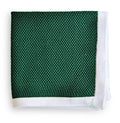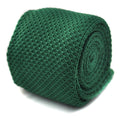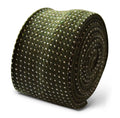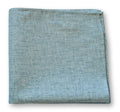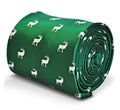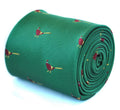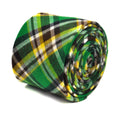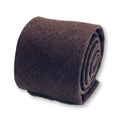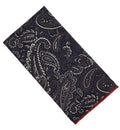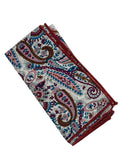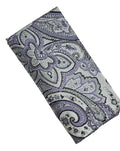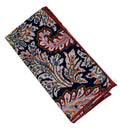Top Haircut Tips: How to Talk to your Barber (And Avoid a Bad Barnet)
Posted by


We’ve all been there – you sit down in the barber’s chair, roughly explain what you want and then wince in horror as your barber cuts too much off of the top, or clips in a few grades shorter than you wanted. And – because we’re British – we sit down and watch as they cut away more than we expected, or give us a completely different style to the one we were expecting to leave with.
But it’s not your barber’s fault. When it comes to our clothes and suits, men are normally clued up on what they want down to the last detail – from the fit down to the buttons. But when it comes to your hair, we’re always quite laid back.
Then there’s the dreaded question:
‘What can I do for you?’
When a barber asks this, he wants to be told exactly what you want doing. The more information you can give him, the closer he can get to the haircut you want.
‘A little bit off of the top, please mate’ doesn’t really give him much to go on, but unfortunately, that’s what most of us say. (Unless, of course, you’re going in for a cut with the clippers – but even then, some men give vague ‘quite short all over’ answers.)
And it’s not a surprise, most of us don’t know how to describe what we want, let alone use the lingo the barber wants to hear. That’s why we put together this cheat sheet for all of the different terms you can use to avoid a quick trip to buy a hat.
FT’s top tip: If in doubt, take a photograph
Before we start with all of the terms, remember that – if you’re in doubt about how to describe what you want, or have a very clear idea of what it is you’re after – the best thing you can do it take a photo along with you. A quick Google image search and screenshot and your barber will know exactly what you’re after without you having to stumble through trying to describe it.
And barbers know hair – they’ll be able to take a look at you and a look at the photo and work out how to get it exactly how you want it, without you guessing on the grades, tapering and length.
Get to grips with the lingo
If you’re after a fairly standard hairstyle – or the thought of taking in a photo doesn’t appeal – then your next best bet is to brush up on your lingo, so that you know your taper from your blocked neckline and your high arch from your natural arch.
The neckline
We know, you can’t see your neckline – but other people can, and it makes a massive difference not only to the overall effect of the haircut, but also to how neat and ‘fresh from the barber’ you look. When it comes to necklines, according to The Art of Manliness (a website that is well worth checking out by the way – it covers everything from grooming and haircuts to survival advice and advice on how to be a man in the 21st Century) you’ve got three choices:

Blocked:
The basic, straight across your natural hairline neckline. This effect is great for special occasions where you need that extra neatness and clean lines. However, within a week or two, that neatness will be gone and you’ll be left with an unkempt neckline. It also makes your neck look a lot thicker, so if you’ve got a pretty sizeable scruff, then it might be better to avoid this one.
Rounded:
Similar to the blocked, the rounded neckline goes across the natural hairline and then up behind the ears, creating a natural curve across the back of your neck. This neckline can look especially great when paired with a suit, as the slight curve of your neckline is matched by the slight curve of your shirt collar and jacket. However, like with the blocked, it doesn’t last all that long and – within a few weeks – it’ll start to look a bit messy. Plus, the bits shaved for the rounded effect start to grow back and give you neck stubble for a little while.
Tapered:
Admittedly, the tapered neckline doesn’t have the same clean finish as the blocked and rounded necklines, but it does have one advantage – it lasts a lot longer, and gives off a much more modern, laid back look. Plus, it doesn’t make your neck look wider, and can even thin a neck out, so is a good option if you’re packing a slightly meatier neck.
The arches
When it comes to the bit around the ears, you only really have two choices: the natural or the high arch.

High arch
A high arch basically means that you ask your barber to cut the arch around your ear into your hairline, giving you space between your hairline and your ear. (If you’ve got smaller ears, a higher arch can make the ears look bigger). Like the blocked or rounded neckline, the only problem with the high arch is its tendency to look a little scruffy as the month between haircuts goes on.
Natural Arch
There’s not much to this one, the barber trims your arches to remove any straggler hairs from hanging over your ear – but it stays a lot more in keeping with the rest of your hairstyle as the month passes.
The texture
The texture of your hair can make a massive difference to the overall look. Make sure you know what you’re after when you step into the chair by brushing up on the following terms:

Choppy
If you could do with a bit of volume – or are going for a messy style that goes up and away from your hairline, a choppy texture might be the one for you. Using the points of the scissors, your barber will cut into the hair at 45 degrees at different lengths, giving you a textured, relaxed look.
Razored
If you’re after a relaxed finish – rather than a fresh from the barber look – then razoring may be the technique you should ask for. Razoring creates a completely different look to scissors – from flatter hair with cleaner lines to relaxed, textured locks.
Layered
Layering – unsurprisingly – is when your hair is cut into layers that lay on top of each other. This can be a particularly great technique if you’ve got thin hair on top (or genetics has kicked in and your hair is slowly moving out), giving the appearance of thickness, depth and volume.


